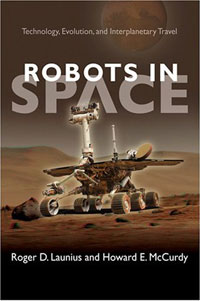Review: Robots in Spaceby Jeff Foust
|
| Even today prominent people question why the United States spends several billion dollars a year on human spaceflight. |
Into this debate step two of the nation’s most prominent space historians and policy experts, Roger Launius and Howard McCurdy, with their new book Robots in Space. While the title suggests a history of robotic (a term they prefer to unmanned, since they note humans are required for the operation of every robotic space mission to date) spaceflight, this book is instead an examination of the history of the various arguments for sending humans and machines into space, and their relative merits. It is an authoritative, detailed look at how these arguments evolved and what the future of humans and robots in space might hold.
Most space advocates would not openly associate spaceflight with utopia, yet that belief, Launius and McCurdy write, is among the roots of the arguments in favor of human spaceflight. Throughout American history there has been the belief that one can better himself—seek utopia—on the frontier, and many space advocates have used that notion to make their case for exploring and settling space. The most successful proponent of human spaceflight, Wernher von Braun, established a paradigm for space exploration at the beginning of the Space Age that put humans at the center in part because of those arguments, they note, coupled with the “ascendancy of Big Science” during that era and the overall growth of government.
That “von Braun paradigm”, though, has run into some obstacles over the decades. Human spaceflight has turned out to be more difficult and expensive than what von Braun and his supporters initially envisioned, and while the US was willing to sustain considerable expenditures on it during the 1960s space race with the Soviet Union, it has been less willing to do so since because of shifting public interests. Also, the von Braun paradigm dramatically underestimated the progress made in robotic spaceflight, as increasingly sophisticated machines are carrying out a variety of missions in space for a small fraction of the cost of a human mission. Many of the basic rationales for spaceflight—science, commerce, and security—can be fulfilled primarily, if not exclusively, by robotic spacecraft, from Mars rovers to communications satellites to reconnaissance spacecraft. The need for humans in space only becomes clear in rationales like national prestige and the long-term survival of the species, of which only the former has been used to successfully win funding—and the authors are skeptical of that argument’s long-term sustainability.
| Concepts like transhumanism sound like science fiction and, for the time being, many of them are—but then, so was spaceflight more than a half-century ago. |
However, Launius and McCurdy don’t endorse a robots-only approach to spaceflight, either. While robotic spacecraft have become sophisticated, there are many tasks that are so complex that either humans alone can do them, or humans can do much more quickly than robots. Robotic spacecraft also lack autonomy, by and large, requiring humans to carefully plan their every operation. The argument that the authors put forward, after a digression on the long-term future of interstellar spaceflight, is for a hybrid approach: combining the durability and efficiency of robots with the intellect and imagination of humans into a single package. This leads to a discussion of cyborgs, nanotechnology, genetics, and other elements of what is often called transhumanism or posthumanism.
Such concepts sound like science fiction and, for the time being, many of them are—but then, so was spaceflight more than a half-century ago. Exactly what form humans and/or robots take in the long-term exploration of space—assuming that civilization does not turn its back to the cosmos—remains uncertain. However, Robots in Space puts forward a strong case that the original arguments for human spaceflight, in the form of the von Braun paradigm, no longer stand up in the face of changing interests and capabilities. As the next president is faced with the challenge of charting the future of America’s human spaceflight program with the retirement of the shuttle and the debate of whether to continue the current exploration architecture, it’s hard to imagine a more important time to question whether and why humans and/or robots should explore the solar system and beyond.
